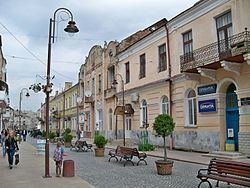Country Ukraine District Zolochiv Raion Postal code 80700 Area 11.64 km² Population 25,000 (2001) | Region Lviv Oblast Time zone EET (UTC+02:00) Area codes +380 3265 Founded 15 September 1523 Local time Sunday 8:44 AM | |
 | ||
Weather 9°C, Wind S at 8 km/h, 78% Humidity Clubs and Teams FC Sokil Zolochiv, Janina Złoczów | ||
Zolochiv (Ukrainian: Золочів, Polish: Złoczów, Yiddish: זלאָטשאָוו, Zlotchov) is a small city of district significance in Lviv Oblast of Ukraine, the administrative center of Zolochiv Raion. The city is located 60 kilometers east of Lviv along highway H02 Lviv-Ternopil and the railway line Krasne-Ternopil. Population: 24,074 (2013 est.). Area — 11,64 km2.
Contents
Map of Zolochiv, Lvivska, Ukraine
History
The site was occupied from AD 1180 under the name Radzicze until the end of the 13th century when a wooden fort was constructed. This was burned in the 14th century during the invasion of the Crimean Tatars.
In 1442 the city was founded as Zolochiv, by John of Sienna, a Polish nobleman of the Dębno family, Although the first written mention of Zolochiv was in 1423.
By 1523 it was already a city of Magdeburg rights.
Zolochiv was incorporated as a town on 15 September 1523 by the Polish king Sigismund I the Old. Located in the Ruthenian Voivodship of the Polish-Lithuanian Commonwealth, it belonged to several noble families.
From the first partition of Poland in 1772 until 1918, the town was part of the Austrian monarchy (Austria side after the compromise of 1867), head of the district with the same name, one of the 78 Bezirkshauptmannschaften in Austrian Galicia province, or "Crown land", in 1900. The fate of this province was then disputed between Poland and Russia, until the Peace of Riga in 1921, attributing Galicia to the Second Polish Republic.
From 15 March 1923 to August 16, 1945, a town in the administrative district of the second Polish Republic in Ternopil. Zolochiv, still named Złoczów, belonged to the Tarnopol Voivodship until the Polish September Campaign in 1939, when it was occupied by the Soviet Union.
After the attack of Nazi Germany on the USSR in June 1941 to July 1944 the city was incorporated into the General Government in the District of Galicia. The Germans occupied the town on July 2, 1941. On the same day attacks began on Jews by local Ukrainians and farmers, who flooded into the town to welcome the German army. The day after, tombs of political prisoners were found in the town, all of them murdered by Soviets before their retreat, and this was a reason for the Ukrainians to make pogroms on Jews. The pogrom began on July 4, 1941. For three days 3,000-4,000 Jews were murdered. The German soldiers were active in the murders. In November 1941, the Germans kidnapped nearly 200 Jewish youngsters to the work camp, Latski-Vielkia. In August 30, 1942, about 2,700 Jews were put inside cattle cars and sent to the Extermination camp Belzec. On November, 1942, Germans and their Ukrainian assistants deported 2,500 old people, women, and children to the same extermination camp. On December 1, 1942 a ghetto was established. Between 7,500-9,000 people were imprisoned there, as well as remnants of communities of the surrounding areas, including Olesko, Sasov, and Biali Kamen. The ghetto was liquidated on April 2, 1943, 6 000 people were murdered in a mass execution perpetrated by an Einsatzgruppen at a pit near the village of Yelhovitsa.
From July 1944 to 16 August 1945 it was again occupied by the Red Army.
After the Yalta Conference (4–11 February 1945), drawn as a consequence of the findings of the interim Government of national unity signed on August 16, 1945, an agreement with the USSR, recognising the slightly modified Curzon line for the Eastern Polish border, on the basis of the agreement on the border between the SOVIET UNION and PKWN Government on July 27, 1944. In the Tarnopol voivodeship agreements Zolochiv was included in the Ukrainian Soviet Socialist Republic in the USSR, where it remained until 1991.
Since 1991 on the territory of Ukraine.
